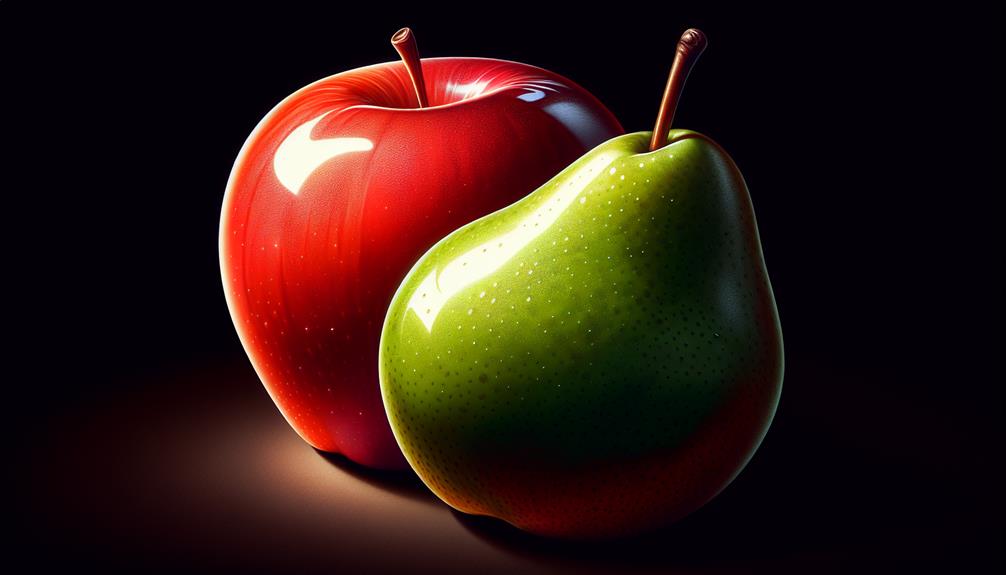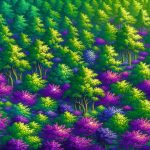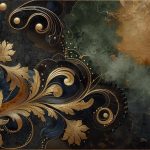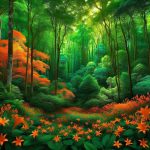I recently discovered a stunning living room design that seamlessly blended red and green hues to create a warm and inviting space.
But do red and green really match? The debate over these two colors goes beyond their placement on the color wheel.
Join me as we explore the fascinating world of color psychology, design aesthetics, and cultural interpretations to unravel the mystery behind the compatibility of red and green.
Table of Contents
Key Takeaways
- Red and green complement each other with vibrant contrast and harmonious balance.
- They symbolize energy, nature, and growth, transcending cultural significances.
- Combining dark tones and a third color enhances the dynamic aesthetic.
- In nature and seasonal decor, red and green create warmth, festivity, and timeless style.
Understanding Color Theory Basics
Color theory basics lay the foundation for understanding how red and green, as complementary colors, interact harmoniously in design and visual arts. Complementary colors are pairs of colors that are positioned opposite each other on the color wheel, creating a vibrant contrast when used together.
In traditional color theory, red and green are considered one such complementary pair. When these two colors are combined, they intensify each other, making the overall design visually striking. This dynamic interaction is why red and green are commonly used together in various art forms to achieve a balanced and harmonious color scheme.
The Psychology of Red and Green
Eliciting distinct emotional responses, red and green intertwine in design to captivate and soothe the human psyche. When considering the psychology of these colors, their unique characteristics play a significant role in how they're perceived and utilized in various contexts.
Here are three key points to explore further into the subject:
- Complementary Colors: Red and green are complementary colors, meaning they're positioned opposite each other on the color wheel. This relationship creates a dynamic visual impact when paired together, making them a popular choice in design for creating contrast and balance.
- Color Psychology: Red is often associated with energy, passion, and intensity. It can evoke strong emotions and grab attention effectively. On the other hand, green symbolizes nature, growth, and tranquility. It's often used to bring a sense of calm and refreshment to a design.
- Harmonious Effects: When combined, red and green can create a harmonious effect that balances the excitement of red with the calming nature of green. This combination is often used in festive contexts to evoke feelings of warmth and balance. Understanding the psychological implications of these colors can help in creating visually appealing and emotionally resonant designs.
Historical Significance of Red and Green
Exploring the historical roots of red and green reveals a rich tapestry of artistic tradition and cultural significance. Red and green have been recognized as traditional complementary colors, a concept that dates back to the 18th-century color wheel model. These colors form a classic complementary pair, known for their visual contrast and harmony in art and design. Artists such as Claude Monet and Vincent van Gogh utilized red and green to create striking visual effects in their artworks, showcasing the timeless appeal of this color combination. Below is a table highlighting the historical significance of red and green as complementary colors:
| Historical Significance of Red and Green | |
|---|---|
| Dating back to the 18th century | |
| Visual contrast and harmony in art | |
| Utilized by famous artists |
The association of red and green with Christmas does not overshadow their versatility and enduring popularity in creative expressions. This dynamic color combination transcends seasonal connotations, offering a vibrant palette for design and aesthetics.
Cultural Interpretations of Red and Green
In various cultural contexts, the hues of red and green hold diverse interpretations and symbolisms that extend beyond their traditional associations with Christmas and holiday festivities.
- Red is often associated with luck and happiness in Chinese culture, symbolizing joy and prosperity in traditional weddings and celebrations.
- In some Middle Eastern countries, green is linked to fertility, growth, and the Islamic faith, representing paradise and the lushness of nature.
- Across Africa, red can signify danger or courage, while green is commonly connected to life, vegetation, and the earth's fertility, reflecting the continent's rich landscapes and vibrant cultures.
The cultural meanings attached to red and green are multifaceted and vary significantly worldwide, showcasing the depth and richness of symbolism that these colors hold beyond their common Western associations. These interpretations highlight the universal appeal and adaptability of red and green in different cultural settings, underscoring their significance in conveying a wide range of emotions and concepts across the globe.
Red and Green in Design Aesthetics
When it comes to design aesthetics, the pairing of red and green can be a powerful tool for creating visual impact. These complementary colors not only contrast beautifully but also evoke feelings of balance, energy, and harmony.
Color Harmony Basics
Red and green harmonize in design aesthetics through their complementary nature, creating a visually striking and dynamic color palette. When exploring color combinations, tones of red play a vital role in balancing the vibrancy of green, creating a harmonious blend that catches the eye.
Utilizing various shades and tones of red and green can add depth and complexity to the overall design, making it more visually intriguing. The contrast between these two colors can evoke traditional associations like Christmas, but they can also be used creatively in non-seasonal contexts to bring energy and vitality to the design.
Properly balancing the intensity of red and green is key to achieving a visually pleasing and aesthetically appealing color scheme.
Cultural Significance Explored
Exploring the cultural significance of red and green in design aesthetics reveals a rich tapestry of meanings and expressions.
Red and green, as a color combination, go beyond their association with Christmas to symbolize energy, passion, nature, tranquility, and balance. This dynamic duo isn't only visually striking but also carries deep cultural connotations.
In art, fashion, and interior design, red and green harmonize to evoke vibrancy, warmth, and visual interest. The versatility of this color pairing allows for sophisticated and diverse design possibilities, transcending traditional boundaries.
Impact on Emotions
Delving into the domain of design aesthetics, the intertwining hues of red and green stir a unique blend of emotions and visual impact.
- The pairing of red and green can evoke a sense of passion and essential balance simultaneously.
- Red brings excitement and intensity, while green symbolizes growth and harmony, creating a harmonious blend of emotions.
- Using red and green in design aesthetics can stimulate essentiality and stability, offering a dynamic visual experience that combines energy and tranquility.
This combination not only conveys a rich visual appeal but also triggers deep emotional responses, making red and green a powerful duo in design aesthetics.
Practical Tips for Combining Red and Green
I've got some practical tips for combining red and green in your design projects.
Let's talk about color harmony, different combinations, and ways to introduce a third shade for added interest and balance.
Mixing these two hues can create vibrant and sophisticated looks when done right.
Color Harmony Tips
When combining red and green in your decor, remember that these complementary colors can create a harmonious and visually appealing color scheme.
- Experiment with textures, furniture, and accessories in red and green to maintain a cheerful ambiance in your space.
- Introducing a third shade alongside red and green can enhance the overall color scheme and add depth to the design.
- By incorporating dark tones with red and green, you can add sophistication to your decor and avoid a solely holiday-themed vibe.
These tips will help you achieve a balanced and aesthetically pleasing look when using red and green in your interior design.
Red and Green Combinations
Exploring practical ways to combine red and green in your decor can result in striking and versatile color schemes. When incorporating a third color into the mix, the overall look can be enhanced, creating a more dynamic and balanced aesthetic. Here is a simple guide to help you master the art of combining red and green with a third color:
| Red Shades | Green Shades | Third Color |
|---|---|---|
| Crimson | Emerald | Gold |
| Burgundy | Olive | Navy Blue |
| Cherry Red | Forest Green | Cream |
| Ruby | Mint | Charcoal Gray |
Red and Green in Nature
In nature, the vibrant hues of red and green often intertwine, symbolizing growth and the beauty of the cycle of life. When exploring the natural world, it's fascinating to observe how these two colors come together harmoniously, creating stunning visuals that captivate the eye and evoke a sense of wonder.
Here are some intriguing instances where red and green converge in nature:
- The leaves of plants and trees during the changing seasons showcase a mesmerizing blend of reds and greens, painting landscapes with a rich tapestry of colors.
- Birds like cardinals and parrots flaunt vibrant red and green feathers, embodying a natural balance of hues that's both striking and beautiful.
- Flowers such as poinsettias and roses exhibit a delightful contrast between their red petals and green leaves, demonstrating nature's artistry in combining these complementary colors.
Witnessing these natural pairings of red and green serves as a reminder of the intricate connections that exist in the world around us, emphasizing the harmony and vitality found in the cycle of life.
Red and Green in Seasonal Decor
As we shift focus to seasonal decor, the timeless combination of red and green takes center stage, embodying the spirit of warmth and festivity associated with Christmas and holiday celebrations. Red is often linked to Santa Claus and holly berries, while green symbolizes Christmas trees and nature. When combined in decor, these colors create a traditional and inviting atmosphere perfect for the holiday season. Mixing various shades and tones of red and green allows for the creation of a harmonious and visually appealing seasonal color scheme that resonates with the joyous themes of the festivities.
| Red | Green | Seasonal Decor |
|---|---|---|
| Santa Claus | Christmas Trees | Traditional Atmosphere |
| Holly Berries | Nature | Inviting Setting |
| Festive Warmth | Joy | Harmonious Color Scheme |
The red and green palette in seasonal decor not only adds a festive touch but also brings a sense of familiarity and tradition to the surroundings, making it a beloved choice for many during the holiday season.
The Future of Red and Green Trends
Red and green's enduring presence in fashion trends for 2024 showcases their timeless appeal and versatility in creating stylish ensembles for the modern wardrobe. As we look towards the future of red and green in fashion, several trends are emerging that highlight their continued popularity and influence:
- Mixing Textures: Experimenting with different textures like silk and wool in red and green pieces adds depth and visual interest to outfits.
- Statement Accessories: Incorporating bold accessories such as oversized belts or chunky jewelry in these colors can elevate a simple look to high fashion.
- Monochromatic Looks: Embracing head-to-toe red or green outfits, including varying shades of the same color, creates a sophisticated and on-trend style statement.
These trends illustrate how red and green can be adapted in innovative ways to stay relevant in the ever-evolving world of fashion.
Frequently Asked Questions
Does Green and Red Go Well Together?
Yes, green and red go well together. The combination creates a harmonious and visually striking look. By incorporating different tones and shades, you can enhance the depth and interest of this color pairing for a vibrant and dynamic aesthetic.
Is It OK to Wear Green and Red?
Wearing green and red together is absolutely okay. These colors, often seen as complementary, can create a vibrant and stylish look. By balancing them well and incorporating other tones or patterns, one can rock this color combo confidently.
Is It True That Red and Green Are Complementary Colors?
Absolutely! Red and green are classic complementary colors that work harmoniously together. Their contrast creates visual interest and makes designs pop. Traditional color systems like RGB and CMYK confirm their relationship, leading to stunning color schemes.
Does Red and Green Match Men?
Absolutely! Red and green can be a fantastic combination for men's outfits. By balancing them with neutral tones, experimenting with different shades and textures, men can create stylish, bold, and festive looks that suit their preference.
- How Does Ring Spun Cotton Affect Garment Fit and Shape Retention? - August 13, 2024
- What Are the Challenges in Producing Ring Spun Cotton? - August 13, 2024
- Is Ring Spun Cotton Suitable for Plus-Size Clothing? - August 13, 2024







